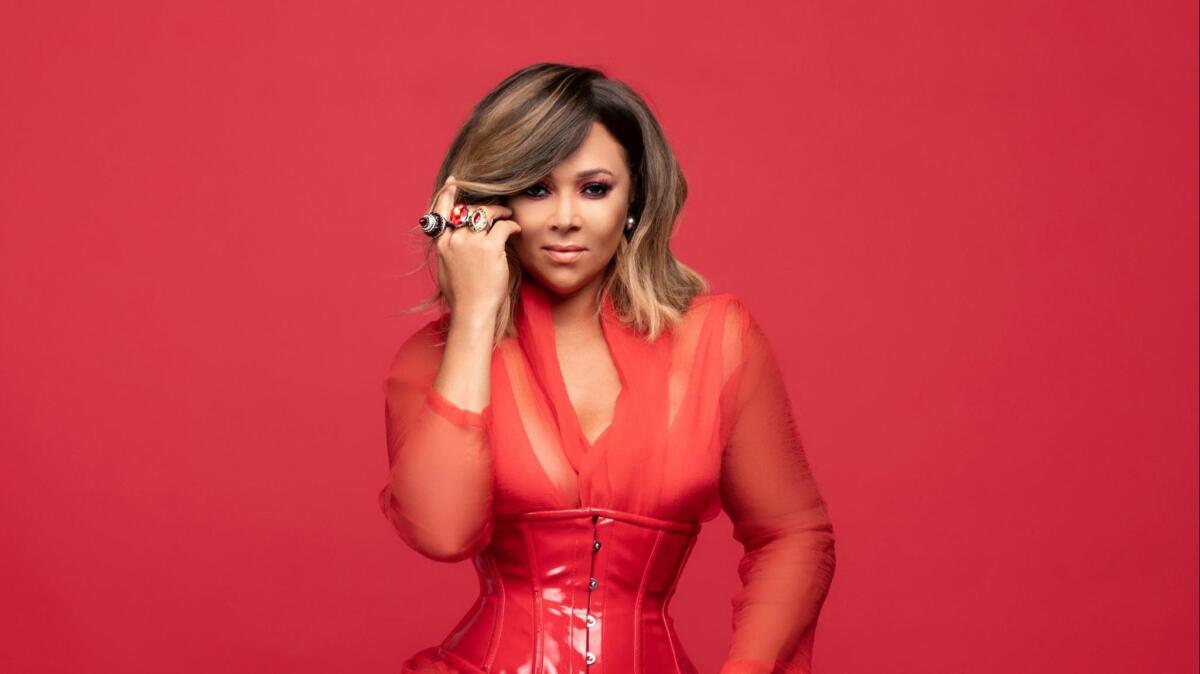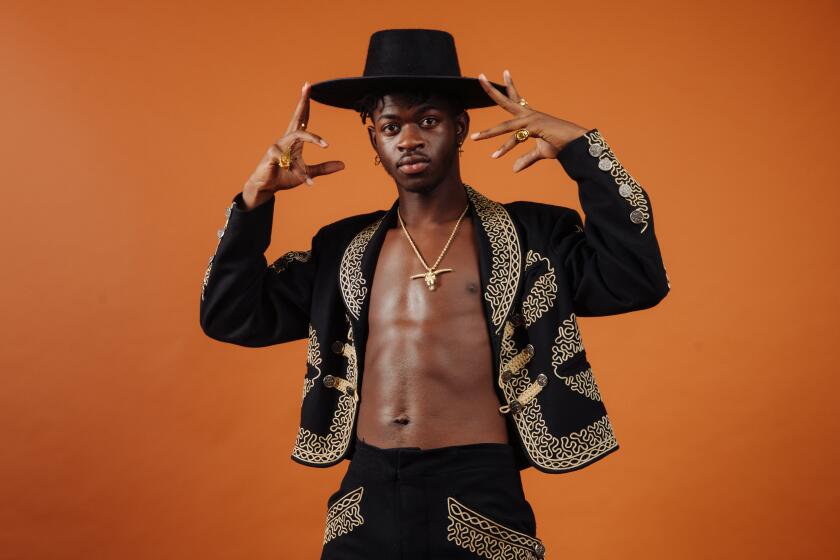How Ledisi, Tamia and more longtime stars survive in an era of young, shape-shifting R&B
- Share via
Tamia, Tank and Ledisi are among R&B’s most revered voices. Their work stretches back to the late 1990s; collaborations with Quincy Jones, Gladys Knight, Aaliyah, Chris Brown and John Legend dot their respective catalogs; and they remain in-demand as touring acts.
Yet it was only in the past few years that they experienced their biggest commercial successes — two decades after their debuts. Tank earned his first platinum single this summer, Ledisi recently clocked her highest-streamed single, while Tamia’s “Leave It Smokin’” from her most recent album “Passion Like Fire” hit No. 2 on Billboard’s adult R&B charts in July and she landed her first No. 1 R&B album with 2015’s “Love Life.”
“What’s amazing is that 20-some odd years after my first album, I got my first No. 1,” Tamia gushed during a recent concert in L.A.
With a slew of young talents leading the way in R&B’s resurgence, artists like Tamia, Tank, Ledisi, Maxwell — and, well, any R&B performer over the age of 35 — have struggled to survive in a genre where shape-shifting and youth is rewarded over tradition.
“Being an older artist, I'm 20-something years in, and having my first moment ever; in a sense, it has given me a different kind of hunger,” says Tank, whose real name is Durrell Babbs. “I’ve made platinum records for everybody else, but this the first time I’ve gone platinum on my work. It feels like I’ve cracked some type of code that can give us all a new lease on life at this age in the game.”
Even a marquee act like Mary J. Blige has felt excluded from the renewed excitement over R&B. Like many artists of her generation, she can’t compete with her own past chart glories, which are frankly impossible to replicate in today’s climate.
“I was hearing it was over [for me]. ‘Had your run, but girl look at the numbers.’ The whole thing,” Blige, 47, says of criticism she faced over dwindling sales. “But I kept going because I know, I felt in my spirit, there's something more that I have to do. There's another message that I have to relay for women.” And even in the changed landscape, her latest album “Strength of a Woman” went to No. 2 on the Top R&B/hip-hop albums chart.
It feels like I’ve cracked some type of code that can give us all a new lease on life at this age in the game.
— Tank
Alan Grunblatt, president of urban and rock at Entertainment One, says he’s been constantly “reprogramming” artists to change their minds on navigating a digital-forward music industry. But he says it’s an uphill battle for veteran artists trying to get attention.
“Radio is always the elephant in the room,” Grunblatt says. “Want to get your records on the radio? You need a record label. But major labels are getting out of R&B, unless it’s the younger stuff. So you have to keep an entire marketing plan to push a record because traditional R&B is not a streaming genre. You go to the [streaming services] and call them out for not supporting R&B and they say, ‘Well, yes we do,’ and then show you a hip-hop/R&B playlist as if these aren’t two different genres.”
Tank, who has written music for Aaliyah, Jamie Foxx and Keyshia Cole, saw it all as an opportunity.
Frustrated by the lack of attention contemporary R&B was receiving on a mainstream level the 42-year-old singer-songwriter-producer decided to stop trying to please the masses. “At this point,” he says, “it’s just about the people that I do touch and the music. I said let me make a record how I feel and let the chips fall where they may.”
The result was “When We,” an unabashed sex jam for the Soundcloud rap era. Its beat has the cold aggression of any rap record dominating radio but comes with the smooth, sensuous croon that made him an R&B breakout when he debuted with 2001’s “Maybe I Deserve.” The song topped the adult R&B charts and went platinum in July and placed Tank in a minuscule club of contemporary R&B artists over 35 to get a platinum single in the last five years (John Legend, Ne-Yo and Beyoncé are the others).
“When we turned this record in, [the label] was like, 'Who do you guys think is gonna play this record?'” he recalls. “And I’m like, ‘Maybe radio won't play it, but this is the record. … Let's get to work.’”
What Tank didn’t know about was his popularity on Spotify — he’s got a little more than 1 million monthly listeners — which proved to be a potent launching pad for “When We.” The record has amassed over 30 million streams since its release last summer.
“I'm known for core R&B and streaming has never been a space catered to traditional R&B,” he says. “To be getting millions and millions of streams it made [radio] say, ‘We have to play this record.’” Soon after, the song crossed over to mainstream R&B and hip-hop airwaves — where Migos and Drake are preferred over crooning.
“I wish I could say I masterminded the whole thing, but that would be a lie,” Tank says with a laugh. “It was about making music and giving it to the people. Where we are today, people don’t have to be programmed by radio. The fact that people have more control over their listening habits — they can search out music and make their own playlists — it’s giving R&B a real shot again.”
To survive, many R&B veterans have had to decide whether it was best to stick with their core fan base or explore new sounds in a bid to reach different audiences.
Take singer-songwriter Ledisi (full name Ledisi Young). Widely beloved in contemporary R&B and soul circles, she has 12 Grammy nominations and eight albums under her belt, but you’d be hard-pressed to find her on any mainstream platforms. “If there’s a tribute on BET, then my phone is ringing,” she says with a laugh. “Outside of that, I don’t know what else to do. I’m singing my lungs out. It’s exhausting.”
Ledisi’s biggest chart hit, 2011’s “Pieces of Me,” was a muscular offering of R&B perfection with warm harmonies, a sweeping bridge and a sultry groove to its beat. But it’s not her most successful record on streaming services. That would be last year’s “High,” her first foray into the “trap soul” vibe that a younger generation of R&B fans — those who came of age at a time when hip-hop and R&B was virtually indistinguishable — is flocking toward.

Trap soul merges rap and R&B with soul and was dominated by male voices like Bryson Tiller, 6lack and Tory Lanez before H.E.R. broke out. Ledisi, 46, knew it was a risk that could alienate her fan base.
“It’s the highest-ranking song I have on streaming, which is amazing, but it was about stretching into different territory with different producers and different sounds that I wouldn't normally use,” she says. “It broadened my audience even more and now my shows are bigger.”
“But,” she adds, “some of my older audience still went, ‘Ugh.’”
Grammy-nominated hitmaker Chuck Harmony (Rihanna, Fantasia, Jazmine Sullivan) says survival for R&B artists sometimes means abandoning the genre.
“Being able to feed your family by doing your craft sometimes means you need to chase popularity,” he says. “Black artists doing R&B, we are always on the ‘chitlin circuit’ per se. We are always a gig away from a good Christmas or a bad Christmas. That’s the hard fact when it comes to black music. There’s a very limited real estate in which black music gets to live and breathe. So you have to count dollar by dollar, gig by gig.”
Even so, Fantasia Barrino, who like many R&B and soul singers has floated between worlds in terms of audience reach, says she refuses to bend.
“Everybody is chasing a dollar, but everybody has forgotten the passion. We need to get that passion back,” says Barrino, who shot to fame as the first black woman to win “American Idol” in 2004.
“I remember calling my label [while recording 2016’s ‘The Definition Of ...’] and crying because I was irritated. There were days I’d leave the studio because of the records they were sending me. I said, ‘This is all I have. This is it. My music. This is how I take care of my children. Don’t send me no more records that ain’t me because I’m not doing them.’”
In 2017, music media analyst Midi Research posited that this year would begin the “maturation phase” of the digital streaming era in which the customer base would widen beyond first adopters and second-wave users (25- to 35-year-olds).
Tank says he’s had to put in more work educating fans and peers in equal measure to embrace streaming. And when it came to releasing her latest album, “Passion Like Fire,” Tamia took a digital-first approach by putting out a number of tracks before the album’s release this fall. It’s a method that’s quite common now but would have never flied when she was putting out records in the ’90s and 2000s — an era in which singles were exhaustively worked.
“Before, you would never do that. You would never release things unless they were for-sure singles,” Tamia says. “There was no taste test like, ‘Here, take a listen.’ But we consume music completely different now.”

Tamia’s latest single, “Leave It Smokin,” like Tank’s “When We,” proved to be a rare smash on R&B radio. The record raced up the urban adult contemporary chart to No. 2 this summer, becoming her most successful single since her breakout 2001 ballad “Stranger In My House,” and now shares airtime with songs from H.E.R., Daniel Caesar and Ella Mai — acts who could barely talk when her first AC hit came out.
“This was a record we didn’t take to mainstream. It doesn’t have a hip-hop artist on it, but it was uptempo and had a younger sound for her,” says Grunblatt. “And it worked.”
Other forms of income for R&B artists lacking current exposure on radio and streaming platforms include producing hip-hop, writing for pop acts or finding other avenues like television — Fox musical dramas “Empire” and “Star” employ a veritable who’s who of R&B talent on screen and behind the scenes.
Touring is robust for those who have made a living on the circuit playing small and mid-level venues (anything below 7,000 seats), but many acts that once lent their voices to hooks for hip-hop tracks have been edged out by auto-tune software that could make a rapper without vocal chops sound like a digitized Sam Cooke.
Traveling to places like South Korea where R&B is a heavy influence on K-pop artists is another option.
“When the money wasn’t coming in we went to Korea and did K-pop and J-pop. They appreciated certain sounds in R&B that we felt were lost in the U.S.,” says producer-songwriter Ray Romulus of multi-platinum collective the Stereotypes. They produced for BoA, SHINee, EXO, Super Junior and f(x) before reuniting with Bruno Mars to work on his new jack swing-inspired “24K Magic” — an album that swept this year’s Grammys, winning for album, song and record of the year.
Going overseas might be extreme for many, but songwriter Claude Kelly (Mars, Brandy, Whitney Houston) argues that finding true success in R&B begins with redefining what that looks like.
“R&B is the only genre where there’s this idea that success means giving up R&B. It’s the only genre where it’s like, ‘You can do R&B, but if you can go pop, say goodbye to R&B.’ In jazz, the truer you are, the better you are. Same in rock. And if you come in the game pop, it’s okay to be unapologetically that,” he says. “But there’s a lot of apologizing we all do, and we’re forced to do it because there’s so many things we’ve had to do in order to make money doing R&B.”
Tank agrees, which is why the R&B star made it a personal mission to shift thinking among his peers.
“As older artists, we have to understand the game has changed,” he says. “Go to Spotify, see your streaming numbers, talk to your fans. It’s important to understand different things you have to do to get yourself in a space where you can be a part of something that didn’t exist 20 years in the game. The kids are having their moment … so now we have to. We have no other choice.”
For more music news follow me on Twitter:@GerrickKennedy
The biggest entertainment stories
Get our big stories about Hollywood, film, television, music, arts, culture and more right in your inbox as soon as they publish.
You may occasionally receive promotional content from the Los Angeles Times.








